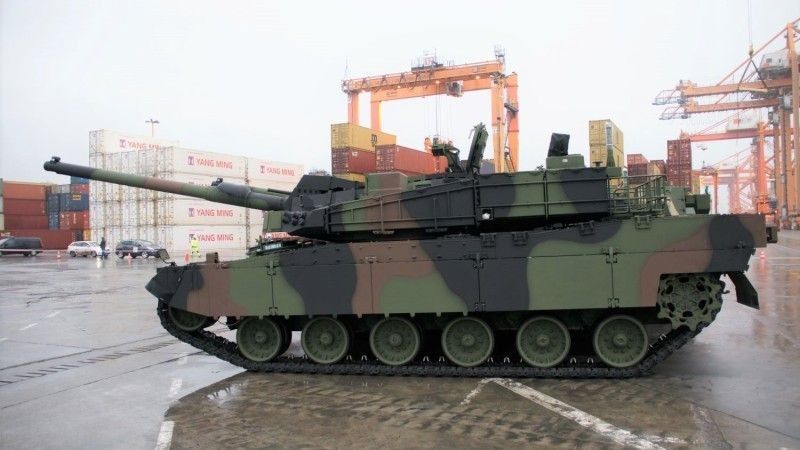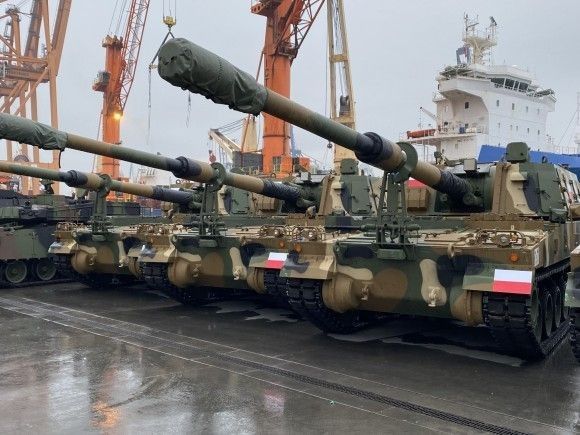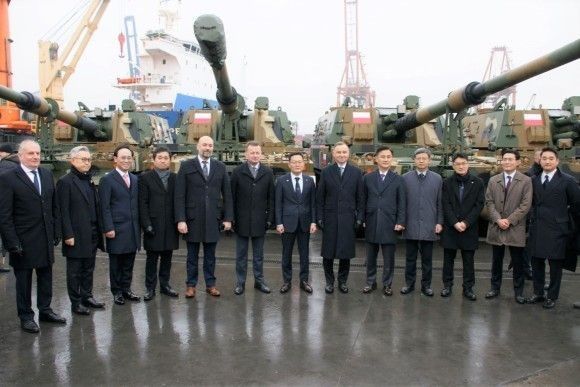Industry
Korea or Nothing. The Only and Last Chance to Boost the Polish Industry [COMMENTARY]

Poland has become the biggest customer of the South Korean defence industry, globally. The deliveries we have been witnessing this week mark just the beginning of a lengthy process, aimed at the reinforcement of Polish security. This paves the way towards bilateral cooperation between the armed forces, but also, above all, creates relevant opportunities for the defence industry. Not only does Poland stand a chance to be a customer, but it could also become a major European industrial cooperation hub. For that hub to be born, major changes in the Polish defence industry are needed.
The first deliveries of Korean equipment (10 K2 MBTs, and 24 K9A1 sphs) just mark the beginning of a grand modernization programme - maybe the most significant in the history of Poland. The value of executory agreements signed, concerning main battle tanks, howitzers, FA-50PL/FA-50 light fighters, and the K239 Chunmoo MLRS systems approached the amount of USD 13.5 bn.
Technology transfer, and further main battle tanks and howitzer agreements are also expected (820 out of 1,000, and 460 out of 672 correspondingly). Another batch of MLRS systems would come next. The value of the Polish-Korean collaboration would be as high as several bn. dollars. One should ask a question now, regarding the benefits that the Polish defence industry and the economy would gain from those deals. Even if the initial deliveries concern Korean-made equipment, even more money is associated with LCC and further equipment lots.
Framework agreements with South Korea also assume that a transfer of technology would happen. To make it possible for the Polish industry to fully utilize the benefits of cooperation with Korea, it is necessary to acquire autonomous manufacturing capacity and export potential. The latter would support the domestic economy that has been burdened with the high cost of financing defence undertakings. And cooperation with Korea is an opportunity to do that, and Poland should make use of that chance. This is not an easy task, and the reasons for that are multiple.
First, the Polish Ministry of Defence has adopted an ambitious timeline, placing the industry in a difficult position, and even worse negotiating position. Less time is available, to establish relevant manufacturing capacity. The MoD's priority is to have the new equipment commissioned ASAP, but this is not aligned with what the industry may want.
Secondly, the Korean partnership is very demanding. The industrial cooperation offer is very broad, but the Koreans are also very well prepared to negotiate, which dictates a high tempo of work. The above means that the Polish teams involved also need to be strong and highly competent.
The PGZ Group remains the weakest link in the process now - and that process is aimed at establishing new industrial capabilities in Poland. One may be under an impression that the PGZ now believes the Koreans can only work with Poland, with long-term investments ahead. And this is an erroneous mindset. If the Poles do not stand up to the challenge of the rapid establishment of a domestic know-how base, focusing on short-term goals instead, then the outcome expected would be a usual one.
Other Central and Northern European states are also interested in Korean products: including Norway, Romania, Czech Republic, Slovakia, and Finland. The defence industries in those countries have also reached high levels of development. If Poland waits before making decisive steps, the European hub may be established in the Czech Republic, Norway, or Slovakia, while Poland would only be left, in the best-case scenario, with a capacity to overhaul the equipment worth billions. A changed attitude towards defence programmes is needed, on the side of the PGZ Group, to broadly introduce manufacturing capacity - also to meet the export demand.
Despite the delays and many unexpected obstacles in the Leopard 2PL programme, the PGZ Group's leadership did not cut its business ties with Silesian facilities and did not stop the trade unions from pursuing their interest, instead of contributing to the development of the Group as a whole. This is quite concerning. Let us recall, the Leopard 2PL programme has now been delayed by at least 6 years when it comes to its completion date (2027, instead of the original deadline set in 2021). Although the PGZ Group has been aware of the problems regarding this programme for years now, no necessary structural changes have been implemented here. If similar practices are not eliminated, the ambitious plans related to the Polish-Korean partnership would crash into the interest groups.
One should recall the way that Korea used to establish its defence market footprint. South Korea has been consequently becoming more, and more ambitious, as an arms exporter. Last year, as Defense News reports, the export value was at the level of USD 7 bn. And it was a record-breaking amount, as the export value doubled, in comparison with the year 2020. This year the export may reach values ranging from several billion dollars, up to USD 20 billion. It all depends on the conclusion of prospective contracts.
And this is a long-term trend that we are dealing with. A report issued by SIPRI suggests that South Korean exports increased, between 2017 and 2021, by 177%, compared to the period between 2012 and 2016. The global market share grew from 1 to 2.8%, placing Seoul ahead of Turkey and Israel. This data does not take the new deals made in Poland into account.

Photo. Jarosław Ciślak/defence24.pl
The South Korean defence industry has been expanded for several years now. It all started with license-manufacturing projects and industrial cooperation, now the Koreans can offer proprietary solutions. And these are a part of the export offer - for instance, the K2 MBT, based on the K1 experiences. The development of the K1 platform has seen a broad involvement of the US industry.
Today the Koreans want to conquer the European markets, to a broad extent. Numerous European states, Poland included, decided to increase the levels of their defence expenditure, following the Russian invasion of Ukraine. Rapid deliveries of modern equipment are often expected. The French, or German defence industries, with a high R&D potential, and a limited manufacturing capacity resulting on the grounds of the previously implemented cuts and low volume of domestic orders, are not always able to meet the demand. The western world does not suffer from a lack of technologies, but the ability to deliver it quickly, and in high volumes is not available, at least immediately. No relevant domestic heavy equipment procurements have been made in recent years.
Meanwhile, the Korean defence industry has been built with an assumption to support the massive, Korean Army, hence the availability of manufacturing headroom. Rapid deliveries are also supported by the Korean work culture, which the Polish industry got a taste of when implementing the Krab howitzer license. The Korean industry, meanwhile, is in need of getting a partner. Not only should that partner be able to establish life cycle support, but also a European supply chain is needed, geographically closer to where the deals are made. Securing the supply chain is becoming increasingly relevant. Deliveries for more than one European customer would justify the expansion of the available potential.
And that role can be played by Poland. One should however remember that South Korea's geopolitical surroundings are uncertain as well. Seoul may also need some procurement support. The assumption behind establishing industrial cooperation between Korea and Poland is that two, co-dependent industrial complexes are established, able to provide mutual support to each other. Maciej Jabłoński, Land Forces Inspector, told us the following in an interview, regarding the K2PL MBT: "The main battle tank expected to be manufactured in Poland, as of 2026, would be very similar to the next version of the Korean MBT. The assumption for it is to be practically identical so that the two manufacturing facilities can strategically support each other, being located in two different geographical regions, in the event of manufacturing problems, or even recovery of losses."
The assumption is then, that the Polish industry would act as a partner for the Korean businesses, also being able to autonomously launch manufacturing and development of comprehensive solutions. If Poland also succeeds in negotiating a set of attractive export conditions, when it comes to the equipment made in Poland, regarding the geographically close region, the transfer of technologies associated with the Korean procurement may become a driving force for the Polish defence industry, also providing a relevant boost for the economy as a whole. Norway, Romania, or other states in the region may have similar expectations though.
Making Use of the Experience
One should, however, remember that the domestic industry in Poland was making attempts at the transfer of technology programmes, expected to support and drive the development of that industry. The KTO Rosomak programme was aimed at establishing competency usable on the global market - and it turned out to be a fiasco. The Polish industry only delivers these APCs for the Polish Army, without yielding full control over the manufacturing process. Some of the performance assumptions adopted when the programme was born, regarding the Rosomak APC, have not been met - for instance, when it comes to the reconnaissance variants. All of the above was caused both by the tough stance adopted by the foreign partner, but also by errors made by the Polish party, at different stages of the programme.
There are multiple examples of such failures. Another, more recent example comes in the form of the Leopard 2PL programme. Here, we are dealing with many years of delays. The programme concerning 142 main battle tanks that have been operated by Poland for years would be finalized after the planned deliveries of more than 400 Abrams and K2 MBTs from the United States, and Korea, not to mention 100 Abrams MBTs expected to be delivered as part of military aid scheme. Furthermore, the agreement regarding that programme did not make (and does not make) a clear division of liability for the work effort. This is one of the reasons for the emerging delays.

Photo. Jarosław Ciślak/defence24.pl
Will the story be different, in the case of the Korean transfer of technology? One can list some positive factors here. Surely, the Koreans need to find a partner and a second manufacturing centre in Europe. The procurement scale has been huge, or even unprecedented. This is an advantage that Poland undoubtedly has.
The Koreans also partially compete against the US defence industry on Polish soil - and the US industry offers an option of expanding the collaboration with the United States, which is a key Polish ally in the defence and security domain. Hence, Seoul needs to place a greater emphasis on the industrial offer, contrary to the Americans, who generally dominate the global arms market.
As I mentioned above, no final decisions have been made yet. Several conditions need to be met, to expand the collaboration with South Korea beyond the realm of procurement or even maintenance, so that it also encompasses the actual establishment of industrial capacity. First, and foremost, the industrial collaboration contracts need to clearly outline the scope of capacities expected to be transferred to Poland, along with the export rights, and the right to develop proprietary solutions, based on the received technologies. Any limitations here may become pricey in the future.
Secondly, the Polish industry needs to be ready to absorb the technologies, and this entails a necessity to make investments, and prepare the personnel. The delivery schedules and timelines are tight. A situation should be avoided, in which more equipment manufactured without, or with limited involvement of the Polish industry is procured.
Thirdly, the PGZ Group's involvement shall be deeper. This is dictated by the necessity to meet the first two requirements. The PGZ Group should have a coherent vision and performance strategy when it comes to this cooperation, that would also be implementable in the Polish context and ensure the maximum possible industrial benefit. Up until now, the ideas and performance were being delivered by the Koreans. The companies that form the PGZ Group can meanwhile focus on pursuing specific projects. One cannot, however, expect them to present a holistic strategy in this scenario.
Finally, should a possibility as such emerge, the cooperation shall be based on mutual benefits only. It would be optimal to fuse the Korean procurement package created by Poland, with the Koreans procuring Polish armament (as it sometimes happens between Israel, and Italy). However, that would rather remain unattainable, at the current scale of procurement made by Poland, given the limited potential of the Polish defence industry. One should remember, however, that some Polish products have already been appreciated by South Korean customers, such as the Łukasiewicz-PIAP bomb disposal robots.
Arrangements made around the export of Korean products to Europe may also play a relevant role here. Poland’s location is proper for manufacturing and maintaining equipment delivered to the NATO allies, potentially expressing their interest in Korean solutions. These decisions need to be made quickly. Other European nations are also interested in working closely with the South Korean industry. These opportunities cannot “get away”.
The current "Korean shopping spree" is the biggest in history, certainly being the biggest apart from the procurements made in the United States. The circumstances also see an opportunity presenting itself, to reinforce the Polish industry. Who knows - maybe it is the last chance to do it, considering the funds involved in the procurement of military equipment, and the LCC. But the opportunity alone is nothing if it is not properly used. To become a partner for Korea, not just a supplier, a couple of conditions need to be met:
Full implementation of the lessons learned during the Leopard 2PL upgrade programme, including, above all, elimination of the pathological business mechanisms, and blocking the detrimental activities of trade unions, hampering both the implementation of the current contracts, as well as the ongoing talks; Expertise reinforcement at PGZ, expansion of the negotiating teams. The Poles need to develop and implement a coherent vision for the whole programme, also keeping up with the tempo dictated by the Koreans, and the surrounding circumstantial context.
The PGZ's support for its companies. The Polish Armaments Group should get involved in support, coordination, and investment at the individual companies gathered within the Group. These investments should make it possible to establish the actual potential necessary to absorb and accommodate the expansive, huge transfer of technologies. PGZ needs to step beyond attending business presentations given by Asian colleagues. The Group should do its own thing, not leave its companies without any support.
The industrial cooperation with South Korea is a huge opportunity that requires specific action (to be taken by the PGZ Group above all), for that opportunity not to be blown. If the effort aimed at significant reinforcement of the Polish defence industry, based on cooperation with Korea, is ultimately a failure, this may lead to stagnation. Should the economy be in a crisis, or if the situation in Europe stabilizes in several years, we may even experience a regressive process here. The lack of driven action would make it impossible for the Polish industry to benefit from the greatest arms procurement programme in history. In case of any problems with procurements made by the Polish Ministry of Defence - that cannot be ruled out as a plausible scenario in a few, or several years - the industry would not be facing stagnation, it would be facing a decline.
